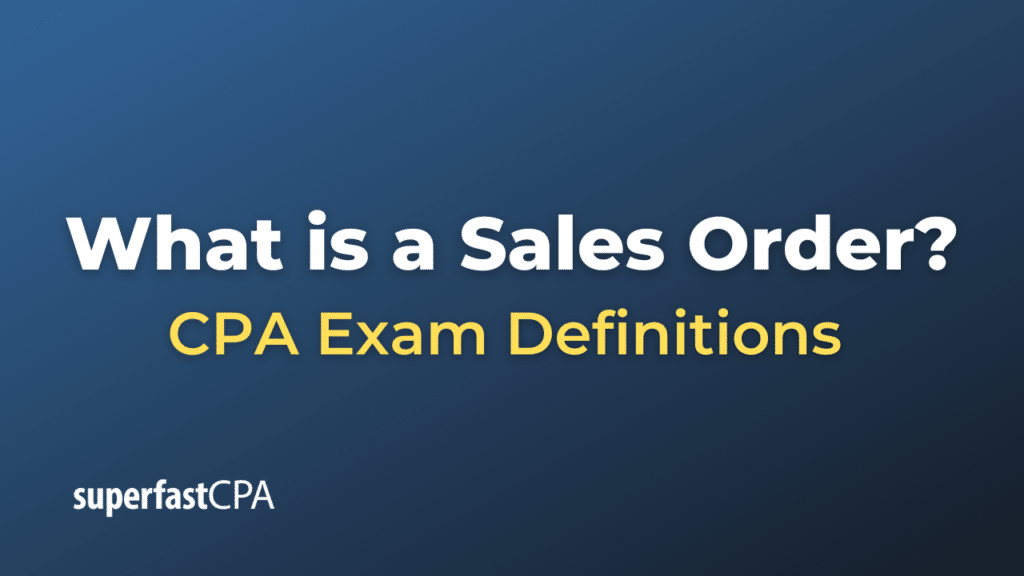Sales Order
A sales order is a commercial document issued by a seller to a buyer, confirming the sale of specified goods or services at a given price. The sales order serves as an agreement between the two parties about the specifics of a transaction, outlining details such as the products or services being sold, quantities, prices, terms, delivery dates, and other relevant terms and conditions. It acts as a formal written commitment that the seller will supply the product or service as described, for the agreed price.
It’s worth noting that a sales order is typically generated after receiving a purchase order (PO) from the buyer. The purchase order communicates the buyer’s wish to purchase certain goods or services, while the sales order is the seller’s confirmation of that request.
Key Characteristics of a Sales Order:
- Document Details: Contains specifics like the order number, date, billing and shipping address, and contact details.
- Product or Service Details: Specifies the products or services being sold, including descriptions, quantities, unit prices, and total amounts.
- Terms and Conditions : Lays out any specific terms related to the sale, such as payment terms, delivery details, warranty or return policies, etc.
- Shipping and Delivery Information: Provides specifics about how and when the products will be delivered to the buyer.
- Signature/Approval: Often, sales orders require a signature or approval mechanism, confirming the agreement’s acceptance by both parties.
- Status Tracking: Many companies use sales order systems that allow for status tracking. This way, both the buyer and seller can monitor the order’s progress from confirmation to shipment and delivery.
Example of a Sales Order
Let’s delve into a practical example to better understand the concept of a sales order.
Company: “Pristine Paper Co.” – A company that specializes in producing high-quality paper products.
Customer: “Artistic Expressions” – An art studio that conducts classes and sells art supplies to the public.
Transaction Details:
- Artistic Expressions” wants to purchase 1,000 sketchbooks and 500 watercolor paper pads for their art studio. They send a Purchase Order (PO) to “Pristine Paper Co.” The PO contains specifics like:
- Sketchbooks: 1,000 units at $5 each
- Watercolor Paper Pads: 500 units at $8 each
- Requested delivery date: September 15th
- Shipping address: 123 Art Street, Creativity City
- Billing address: Same as the shipping address
- “Pristine Paper Co.” reviews the PO and determines they can meet the request. They then generate a Sales Order with the following details:
- Order Number: SO-78910
- Date: August 10th
- Billing Address: 123 Art Street, Creativity City
- Shipping Address: 123 Art Street, Creativity City
- Product Details:
- Sketchbooks: 1,000 units at $5/unit = $5,000
- Watercolor Paper Pads: 500 units at $8/unit = $4,000
- Total Amount: $9,000
- Delivery Date: September 15th
- Payment Terms: Net 30 (Payment due within 30 days of delivery)
- Other Terms: Returns allowed within 15 days of delivery, provided the products are undamaged.
- The sales order is sent to “Artistic Expressions” for review and acceptance. Once “Artistic Expressions” confirms the details are correct and agrees to the terms, they acknowledge the sales order. This serves as a mutual agreement, and “Pristine Paper Co.” will now proceed to prepare the goods for shipment.
In this example, the sales order acts as the bridge between the buyer’s desire to purchase (expressed in the PO) and the seller’s commitment to sell the specified products under the agreed terms. This formalized process helps ensure clarity and avoid misunderstandings in business transactions.













